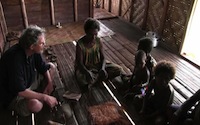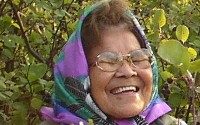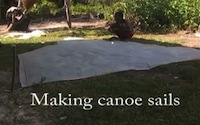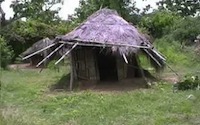The history, language, and culture of the Vilela people have been scarcely documented. Most specialized bibliography -whether ethnographic, historical, or linguistic in nature- published during the 20th century took their extinction or near-extinction for granted.
In historical terms, it is impossible to deny the decrease in their population, their geographical dispersion, and the political and cultural disruption that the Vilela people have experienced, including gradually having to abandon their traditional practices and the use of their language. Elena Lozano, an Argentine linguist who worked with Vilela consultants, pointed out that very few speakers of the language remained. She also recorded the existence of a few Vilela families in the town of Quitilipi (Lozano 1970). However, ethnographic information collected in the early 1990s revealed that some aspects of the Vilela cultural tradition have been maintained (Terán 1995).
Since the 19th century, groups of Vilela people have been culturally integrated into Toba communities. No Vilela communities exist at present, but there are individuals and families who identify themselves as Vilela, even though these people have no political and legal representation in Argentina.
Their lives are currently led under socioeconomic conditions that reflect the typical patterns of the aboriginal population in the Chaco area in general. In rural areas, economic activities, such as agriculture (generally, seasonal sowing and harvesting tasks), cattle raising, and lumber mills employ aboriginal workers as cheap labor. Family sustenance is supplemented with small-scale farming (cotton, mandioca, corn, and alfalfa) both for consumption and for trade, and to a lesser degree with marisca, a Creole term for hunting, fishing and gathering. In periurban settlements, some members of each family may be employed in the informal sector or in the local administration.
The lack of recent records, their socio-cultural integration with other groups, and the wide geographical expansion of the current Vilela population make it impossible to estimate the number of Vilela people. The results of the National Census of Indigenous Population (now in progress) will be of vital importance in shedding light on this issue.
History
Spanish chroniclers in the 17th century began to use the term “Vilela” to identify various subgroups living on both sides of the middle Bermejo River in the Central Chaco region. Jesuit missionaries used the term “Vilela nation” to refer to groups of diverse origin, some of whom had been compelled to join the colonial world as from the 16th century -mostly through the system of forced labor called encomienda.
Jesuit missionaries recorded that the subgroups then constituting the “Vilela nation” and speaking its language were the Vilela -specifically, the Chunupi, the Pasain, the Atalala, the Uacaa, the Ocole, the Ipa, the Yecoanita, the Yooc or Guamalca, the Omoampa, and the Yeconoampa (Furlong Cardiff 1939).
Some of these subgroups appear to have been mainly nomadic hunter-gatherers, while others were basically sedentary farmers, developing industries like loom weaving, among others. The Vilela belonged to the “foot Indians”, although some subgroups may even have ridden horses. In addition, they traveled in canoes, which they also used for fishing in the rivers. According to historical sources, the Vilela were peaceful people, keen on singing and dancing. Albeit able weapon users, they only went to war to avenge attacks or to defend themselves against other peoples. With the exception of the alliances between the subgroups in the military area, no form of political centralism seems to have existed among the Vilela beyond the leadership and the relative authority of the “cacique” or chief. The widespread shamanic practices granted social status and a certain degree of power (Lozano 1970).
In the following centuries, some of these subgroups began to migrate along the Bermejo River, spreading to the banks of the Paraná River. This is the site where historical sources locate the last significant Vilela settlements in the late 19th century (Fontana 1977). Other groups apparently remained in their old habitats or migrated to the northwest, joining other Wichi communities in the province of Salta (Pelleschi 1881).
Early 20th century records show Vilela settlements where the families worked under semi-slave-like conditions, both on the Las Palmas sugar plantation and on the farms of foreign colonists in the province of Chaco








